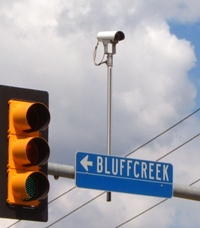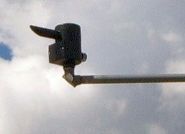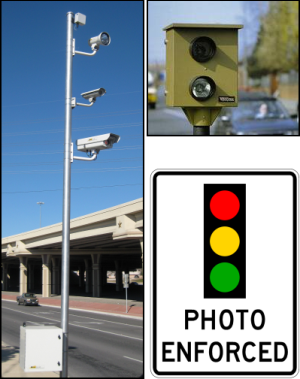|
||
|
|
||
This page last updated January 31, 2025 |
Over the past couple of decades, cameras at traffic signals have become ubiquitous. During the same period, red-light enforcement cameras have been installed in many locations, and there has been much publicity about them. As a result, many people believe that all the cameras they see at traffic signals are enforcement cameras. However, this is usually not the case. Below are pictures of the various cameras you'll see at traffic signals, an explanation of their purpose, and a discussion of red-light cameras in Texas.
|
ADVERTISEMENT |
Traffic detection camera
This is the most common camera type in use at intersections nowadays, and the one most people (including the media) often observe and mistake for a red-light camera. This camera, however, is actually a video image vehicle detection system (VIVDS). These cameras are used by the traffic signal controller computer to determine the presence of vehicles so that it can change the signals accordingly. This function used to be performed by inductive loop detectors in the pavement (and, in many places, still is). However, the cameras are more cost-effective and flexible than loop detectors, which are fairly expensive to install, have a somewhat high failure rate, have limited capabilities compared to video recognition, and cannot be easily reconfigured if needed.

Aside from their use at signals, VIVDS cameras are also used to monitor traffic levels and perform traffic counts.
Although these cameras are not red-light enforcement cameras per se, VIVDS cameras are often used in red-light camera installations as the mechanism to detect when vehicles have entered the intersection. They may be dedicated to that purpose (i.e. separate from the signal controller cameras) or they may serve both purposes. However, it's important to remember that the presence of these cameras in most cases does not mean the intersection has photographic red-light enforcement; see the "red-light enforcement cameras" section below to see what those cameras look like.
One drawback of VIVDS cameras is that they are often not effective during periods of inclement weather, so in many cases, they are now being replaced with acoustic, microwave, infrared, radar, and ultrasonic detectors. These look like small white panels or boxes mounted on the signal poles.
Signal preemption receiver
This is not even a camera, but rather an infrared receiver. These are part of a traffic signal preemption system that allows emergency vehicles — and sometimes public transportation vehicles — to request a green signal as they approach an intersection.

In many places, these are being retired and replaced with GPS-based preemption systems. In those systems, the authorized vehicles send their current location to a centralized computer constantly, which then notifies the signals along their route to change as they approach.
Red-light enforcement cameras
These are actual red-light enforcement cameras. The assembly at the far left is a typical modern red-light camera, while the green boxy one is an older style but still in use in some places.

Images and recordings are then retrieved by or transmitted to the law enforcement agency with jurisdiction over that intersection or their contractor for review. In cases where the images clearly show a violation, a citation is sent to the registered owner of the vehicle. Photos of non-violations or of situations that are less definitive are discarded.
In Texas and many other places, a sign similar to the one shown here is required to be placed on the approach to an intersection with red-light enforcement cameras.
After many years of public push back, the Legislature passed a law in 2019 that banned enforcement cameras, and nearly all cities in Texas scrapped their red-light camera programs as a result. But the law grandfathered cities with existing contracts that didn't have a termination clause, allowing them to continue their use until the contract expires. By the end of 2019, only four cities still had active cameras: Amarillo, Balcones Heights, Humble, and Leon Valley. Amarillo's program ended in August of 2022. Humble and Balcones Heights were scheduled to end in 2024. Leon Valley, however has a contract through 2039, but local leaders there are looking for ways to possibly terminate their contract before then.
Before the 2019 law, red-light camera tickets were civil violations, much like most parking tickets, so it would not go on your driving record, and you would not be arrested for not paying it. Instead, failure to pay could result in your vehicle registration being denied, and prior to 2007, it could be reported to a credit bureau.
But the Legislature has done away with all of that. The 2007 law prevented reporting of unpaid red-light cameras to credit bureaus (but it can still go to a collection agency), and the 2019 law prohibits the Texas DMV and county tax offices from refusing to register any vehicles that have outstanding red-light camera violations.
So to summarize:
- A warrant cannot be issued and you cannot be arrested for not paying a red-light camera ticket.
- Failure to pay a red-light camera ticket cannot be reported to a credit bureau. It can, however, be sent to collections.
- Your vehicle registration cannot be denied for an unpaid red-light camera ticket.
- You cannot be sued for not paying.
So, it appears there are no legal or financial repercussions if you don't pay these tickets. But, if you want to avoid the hassle of getting violation letters or collection calls, or if you just feel a moral obligation to pay, then that's up to you.
A link to the 2019 bill that outlawed red-light cameras is in the "Other sites of interest" section below, along with a report from the Legislative Budget Board in 2013 giving the status of red-light camera laws and operations in Texas at that time.
Other sites of interest
|
|
Image Sensing Systems - Video Detection Products https://www.imagesensing.com/ |
|
|
Wikipedia: Traffic signal preemption https://en.wikipedia.org/ |
|
|
Texas House Bill 1631 (2019 law that banned enforcement cameras) https://capitol.texas.gov/ |
|
|
2013 Legislative Budget Board report on red-light cameras https://www.lbb.texas.gov/ |


